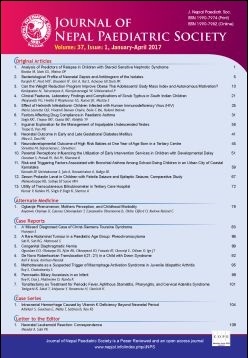Neurodevelopmental Outcome of High Risk Babies at One Year of Age Born in a Tertiary Centre
DOI:
https://doi.org/10.3126/jnps.v37i1.16242Keywords:
Developmental delay, High-risk, One yearAbstract
Introduction: With increasing survival of high risk babies, children with different developmental disabilities have emerged as a challenge for the baby, family as well as for physicians. With limited awareness and resources, follow-up and interventions for these babies are difficult. The study was carried out to find out the development of high risk babies in different developmental domains at one year of age.
Material and Methods: NICU graduates who visited high risk clinic at one year of age were assessed. ASQ-3 was used to screen development. Children with major congenital anomalies and syndromes were excluded from the study.
Results: Out of 28 high risk babies, about 29% had global delay. Those babies who had seizure during neonatal period could not score even in single item of ASQ-3.
Conclusion: All high risk babies are at risk of developing delay hence should be followed up regularly. Timely early intervention needs to be started to minimize delay.
Downloads
Downloads
Published
How to Cite
Issue
Section
License
Authors who publish with this journal agree to the following terms:
Authors retain copyright and grant the journal right of first publication with the work simultaneously licensed under a Creative Commons Attribution License that allows others to share the work with an acknowledgement of the work's authorship and initial publication in this journal.
Authors are able to enter into separate, additional contractual arrangements for the non-exclusive distribution of the journal's published version of the work (e.g., post it to an institutional repository or publish it in a book), with an acknowledgement of its initial publication in this journal.
Authors are permitted and encouraged to post their work online (e.g., in institutional repositories or on their website) prior to and during the submission process, as it can lead to productive exchanges, as well as earlier and greater citation of published work (See The Effect of Open Access).



